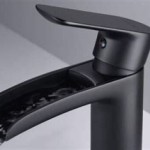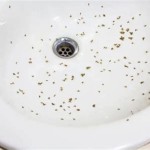Fruit Flies in Bathroom Sink Drain: Understanding the Infestation and Effective Control Strategies
The presence of fruit flies in a bathroom, particularly around the sink drain, is a common nuisance. While often associated with overripe fruit in the kitchen, these tiny insects can thrive in the moist, organic-rich environment of a bathroom drain. Understanding the reasons behind this infestation and implementing effective control strategies is crucial for eliminating the problem and preventing future occurrences.
Fruit flies, belonging to the family Drosophilidae, are small, winged insects known for their rapid breeding cycle. They are attracted to fermenting sugars and decaying organic matter, making a bathroom sink drain an ideal breeding ground. The drain provides a consistently moist environment where organic debris, such as hair, soap scum, and toothpaste residue, accumulates and decomposes. This decomposition process creates the necessary food source and breeding medium for the fruit flies.
The life cycle of a fruit fly consists of four stages: egg, larva, pupa, and adult. Female fruit flies lay their eggs on the surface of the decaying organic matter. These eggs hatch into larvae, which feed on the organic material for several days. After maturing, the larvae transform into pupae, which undergo metamorphosis before emerging as adult fruit flies. This entire life cycle can be completed in as little as eight to ten days under favorable conditions, leading to a rapid increase in the fruit fly population.
The presence of fruit flies in a bathroom can be frustrating and unhygienic. They can contaminate surfaces with bacteria and other microorganisms, and their constant buzzing can be irritating. Controlling fruit fly infestations requires a multi-pronged approach that addresses both the elimination of existing flies and the removal of breeding sites. Neglecting to address both aspects will result in a recurring problem.
Identifying the Source and Extent of the Infestation
The first step in controlling a fruit fly infestation in a bathroom is to accurately identify the source and extent of the problem. While the sink drain is the most likely culprit, it is essential to rule out other potential breeding sites in the bathroom. These can include:
Toilet Bowl: Although less common than drain infestations, fruit flies can sometimes breed in the toilet bowl, especially if it is not flushed regularly or if there is a buildup of organic matter in the bowl.
Shower or Bathtub Drain: Similar to the sink drain, the shower or bathtub drain can accumulate hair, soap scum, and other organic debris, creating a suitable breeding ground for fruit flies.
Damp Mops or Cleaning Cloths: Damp mops or cleaning cloths left in the bathroom can also provide a moist environment for fruit flies to breed, particularly if they are contaminated with sugary or organic residues.
Potted Plants: Overwatered potted plants can attract fruit flies, as the moist soil provides a suitable breeding ground for some species. Overripe or decaying organic matter in the soil can exacerbate the problem.
Once the source of the infestation has been identified, it is important to assess the extent of the problem. This can be done by observing the number of fruit flies present in the bathroom and tracking their movements to pinpoint their breeding sites. A simple trap can also be used to monitor the fly population. Filling a small dish with apple cider vinegar and a drop of dish soap will attract and trap the flies. The number of flies caught in the trap can provide an indication of the severity of the infestation.
Accurate identification of the breeding source and the extent of the infestation is crucial for selecting the most effective control strategies. Targeting the breeding sites directly is essential for eliminating the problem at its root.
Effective Drain Cleaning and Elimination of Breeding Sites
The cornerstone of fruit fly control in bathroom sink drains is thorough cleaning and removal of breeding sites. This involves removing the organic debris that accumulates in the drain and plumbing system. Several methods can be employed to achieve this:
Boiling Water Flush: Regularly flushing the drain with boiling water can help to dislodge and dissolve organic matter. This method is simple and effective for preventing the buildup of debris. It is important to exercise caution when handling boiling water to avoid burns.
Vinegar and Baking Soda Solution: A mixture of vinegar and baking soda can create a fizzing action that helps to break down organic matter in the drain. Pouring half a cup of baking soda followed by one cup of vinegar into the drain, allowing it to fizz for 30 minutes, and then flushing with hot water can be effective.
Drain Cleaners: Commercial drain cleaners can be used to dissolve stubborn organic matter. However, it is important to use these products with caution, as they can be corrosive and harmful to plumbing systems. Follow the manufacturer's instructions carefully and avoid using excessive amounts.
Drain Snake or Plunger: A drain snake or plunger can be used to physically remove accumulated debris from the drain. These tools can be particularly effective for clearing clogs caused by hair and other solid materials.
Professional Drain Cleaning: In severe cases, it may be necessary to hire a professional plumber to clean the drain. Plumbers have specialized tools and equipment to thoroughly clean the drainage system and remove stubborn blockages.
In addition to cleaning the drain itself, it is also important to clean the surrounding areas, such as the sink basin and countertop. Wipe down surfaces with a disinfectant to remove any potential food sources or breeding sites. Regularly clean and disinfect damp mops and cleaning cloths to prevent them from becoming breeding grounds for fruit flies.
By consistently maintaining a clean drain and bathroom environment, the risk of fruit fly infestations can be significantly reduced. Preventing the accumulation of organic matter is key to eliminating the food source and breeding medium for these pests.
Implementing Targeted Control Measures for Adult Fruit Flies
While eliminating breeding sites is crucial for long-term control, it is often necessary to implement targeted control measures to quickly reduce the population of adult fruit flies. Several methods can be used to achieve this:
Fruit Fly Traps: As previously mentioned, apple cider vinegar traps are an effective way to attract and trap adult fruit flies. Other attractants, such as overripe fruit or wine, can also be used. Adding a drop of dish soap to the attractant will break the surface tension of the liquid, causing the flies to drown.
Fly Paper or Sticky Traps: Fly paper or sticky traps can be placed near the sink drain or other areas where fruit flies are commonly seen. These traps will capture and kill the flies as they land on the sticky surface.
Insecticide Sprays: Insecticide sprays can be used to kill adult fruit flies on contact. However, it is important to use these products with caution, as they can be harmful to humans and pets. Choose a product that is specifically labeled for use against fruit flies and follow the manufacturer's instructions carefully. Avoid spraying near food preparation areas or on surfaces that come into contact with food.
Vacuuming or Swatting: In some cases, simply vacuuming up or swatting the flies can be an effective way to reduce the population. This method is particularly useful for small infestations or when chemical control is not desired.
Biological Control: Introduce natural predators to the area. Predatory mites, for instance, prey on fruit fly larvae and can be an effective long-term control strategy. Releasing these mites near the drain area can help reduce the population of fruit flies by targeting their immature stages.
When using any control measure, it is important to target the areas where fruit flies are most active. Focus on treating the sink drain, surrounding surfaces, and any other potential breeding sites. Persistence and consistency are key to achieving effective control. Regularly monitor the fly population and adjust control measures as needed.
Combining these targeted control measures with the elimination of breeding sites will provide a comprehensive approach to managing fruit fly infestations in bathroom sink drains. Addressing both the adult flies and their breeding grounds is essential for achieving long-term success.
The presence of fruit flies in a bathroom sink drain indicates the presence of a suitable breeding environment. By implementing the strategies outlined above, a homeowner can effectively eliminate the infestation and prevent future occurrences, ensuring a cleaner and more hygienic bathroom environment.

How To Rid Of Drain Flies Forbes Home
Jab Plumbing Solutions Blog Blocked Drain Plumbers
How To Get Rid Of Gnats Drain Flies Fruit And Fungus

How To Get Rid Of Drain Flies Rt Olson Plumbing

Fruit Flies In The Bathroom Get Rid Of Them Michael S Plumbing Orlando

The Simple Trick To Stop Pesky Gnats From Taking Over Your Drains

How To Get Rid Of Drain Flies Moth And Prevent An Infestation Pest Defence

Are Your Drains Drawing Bugs May Exterminating

How To Get Rid Of Drain Flies

Fruit Flies Gnats Or Drain Pronto Pest Management
Related Posts







